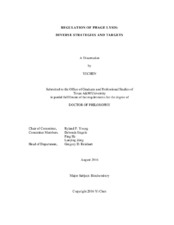| dc.description.abstract | Most of the large, double-stranded DNA (dsDNA) bacteriophages infecting Gram-negative hosts utilize multi-protein strategy to lyse the three layers of the host cell envelop: the inner membrane (IM), the peptidoglycan (PG), and the outer membrane (OM). Four sets of proteins were illustrated in the phage lysis paradigm: holin (IM lesion formation), antiholin (inhibition of holin), endolysin (PG degradation), and spanin complex (OM disruption).
The classic myophage T4 has a very unique feature called Lysis Inhibition (LIN) for regulating the lysis time in response to the superinfection (when a second T4 or T-even phage infects a T4-infected cell). The latest results showed that in addition to the main antiholin RI, which binds to the periplasmic C-terminal domain of T4 holin T, a T4-encoded soluble protein RIII is also required for LIN. Bacterial two-hybrid and Pull-down assays showed that RIII interacts with the cytoplasmic N-terminus of T. Therefore, RIII is considered as a cytoplasmic antiholin of T4.
For another well-studied coliphage Mu, the detail of its lysis system was obscure for decades. The new results suggested that Mu adopts the classic lysis paradigm, consists of the newly-identified holin-antiholin pair Gp19 and Gp20, the SAR-endolysin Lys, and the spanin complex Gp23/23a. Lys has an N-terminal SAR (Signal-Anchor-Release) domain, which makes Lys capable of escaping the IM gradually and spontaneously. However, unlike other previously studied SAR-endolysins, Lys expressed from the plasmid in low level did not lead to cell lysis unless it was co-expressed with Gp25, the product of Mu gene 25. The most reasonable explanation is that Gp25 is required for the release of Lys from the IM by neutralizing the basic residues in the cytoplasmic domain of Lys. Therefore, Gp25 is a novel regulatory factor in the phage lysis paradigm that targets SAR-endolysin.
In sum, these studies proposed new models for lysis regulation. In T4, the current model for LIN involves the stabilization of a complex of three proteins in two compartments of the cell. In Mu, the discovery of the Gp25 suggested the involvement of a new class of protein factor that regulates lysis by targeting endolysin. | en |


